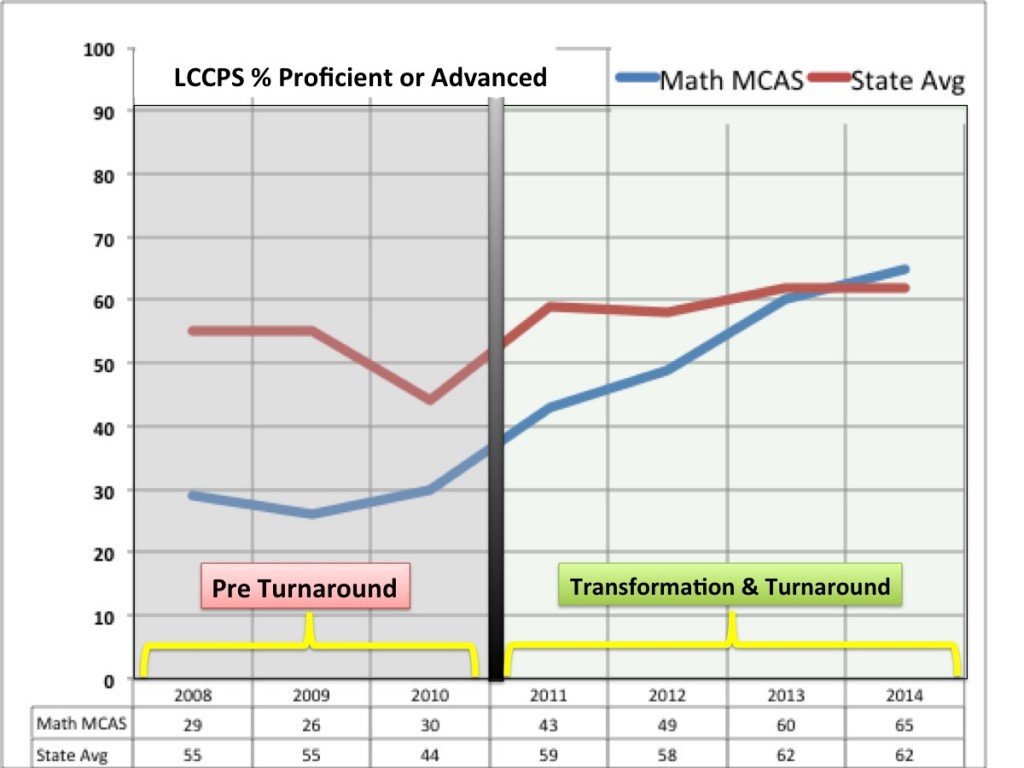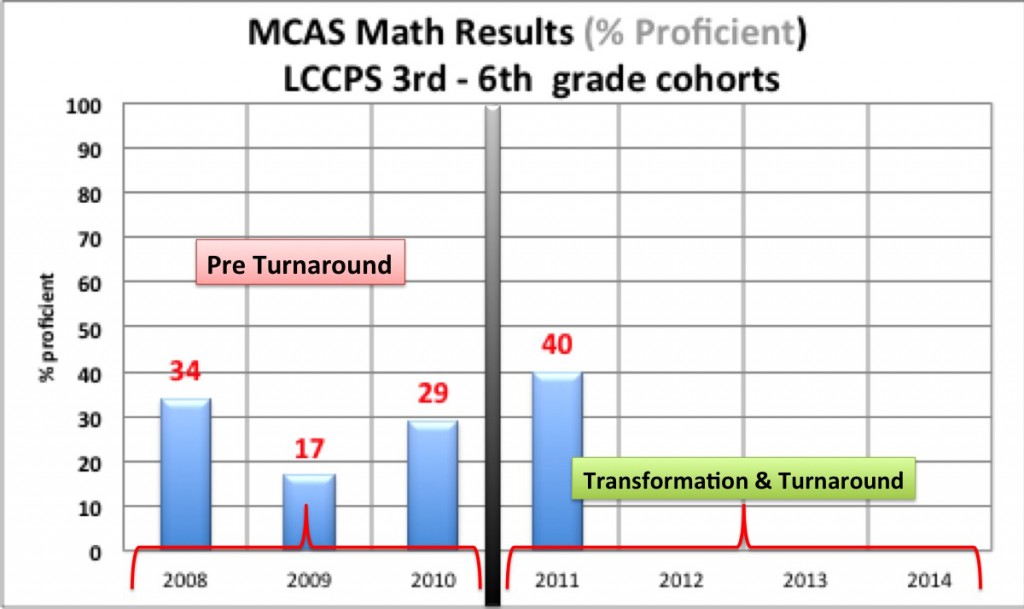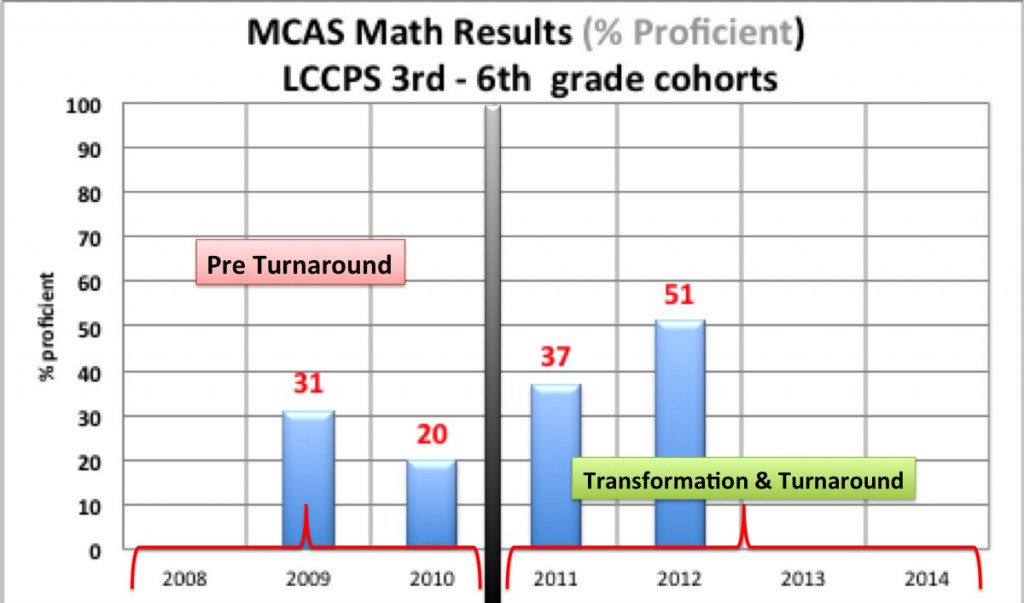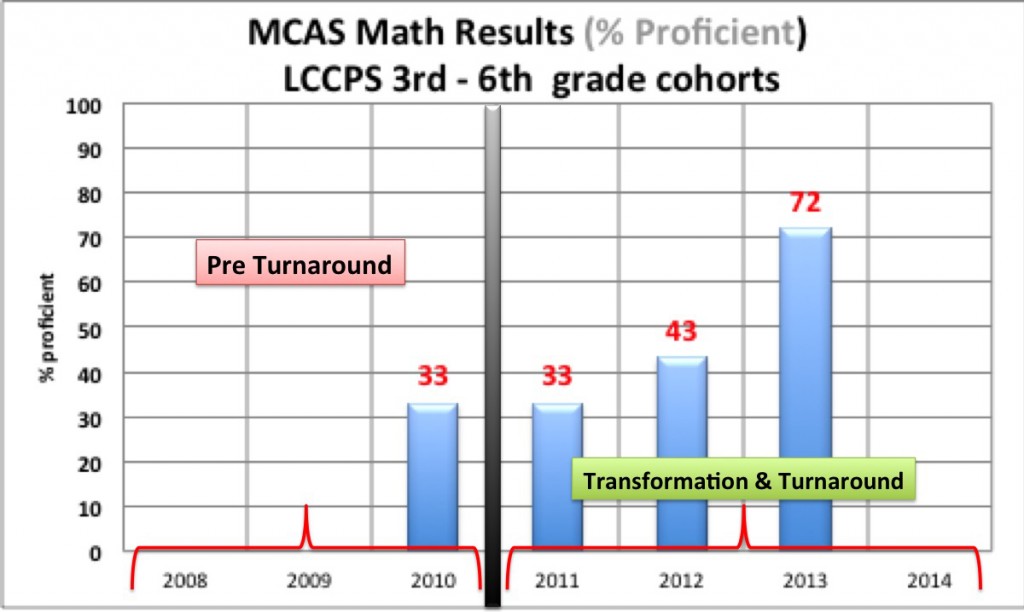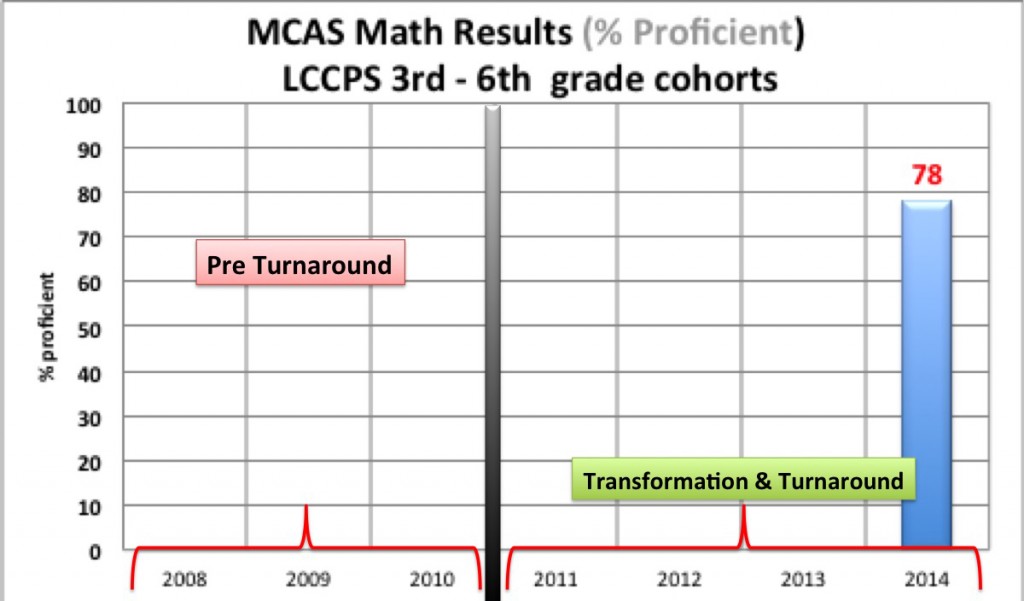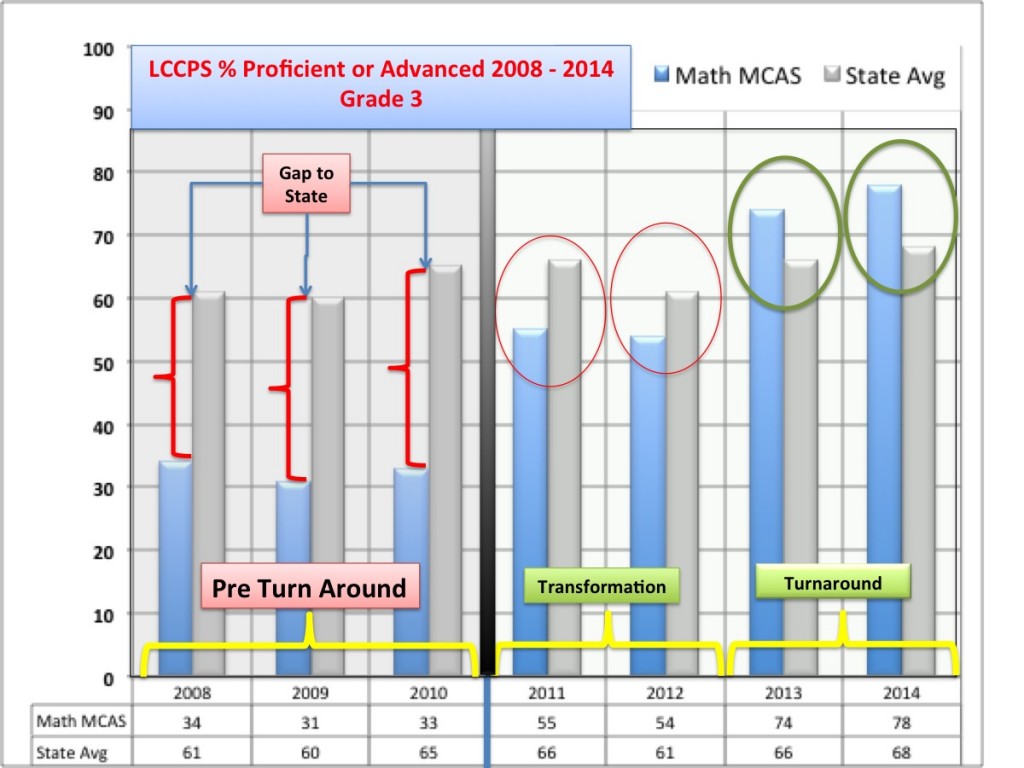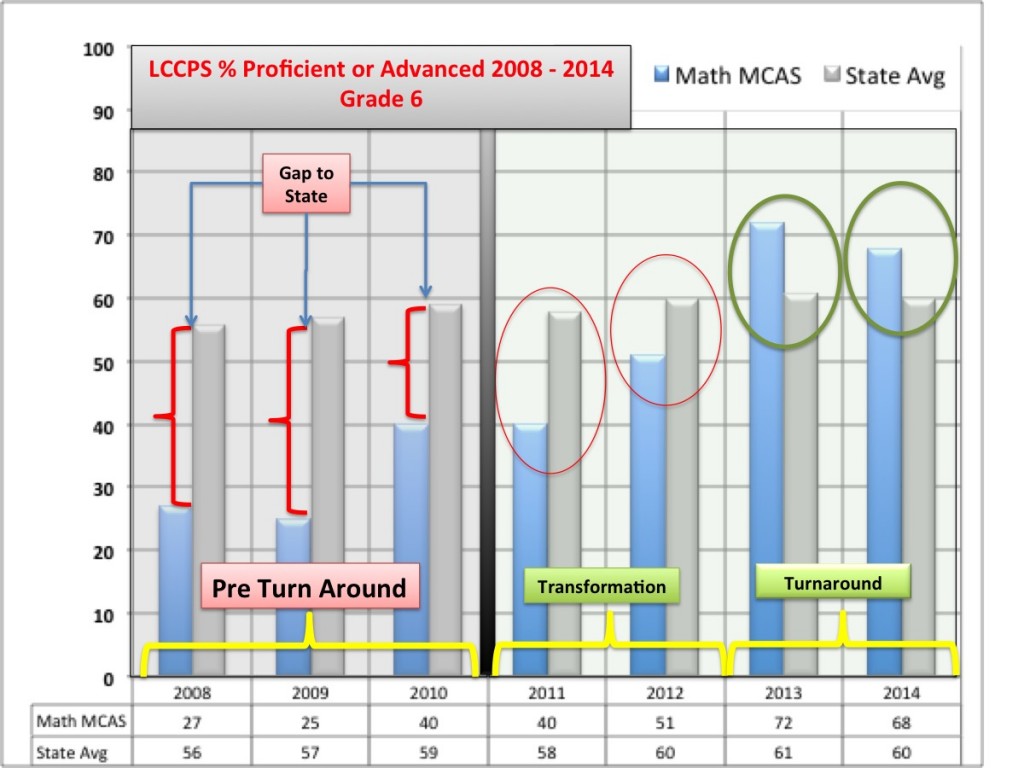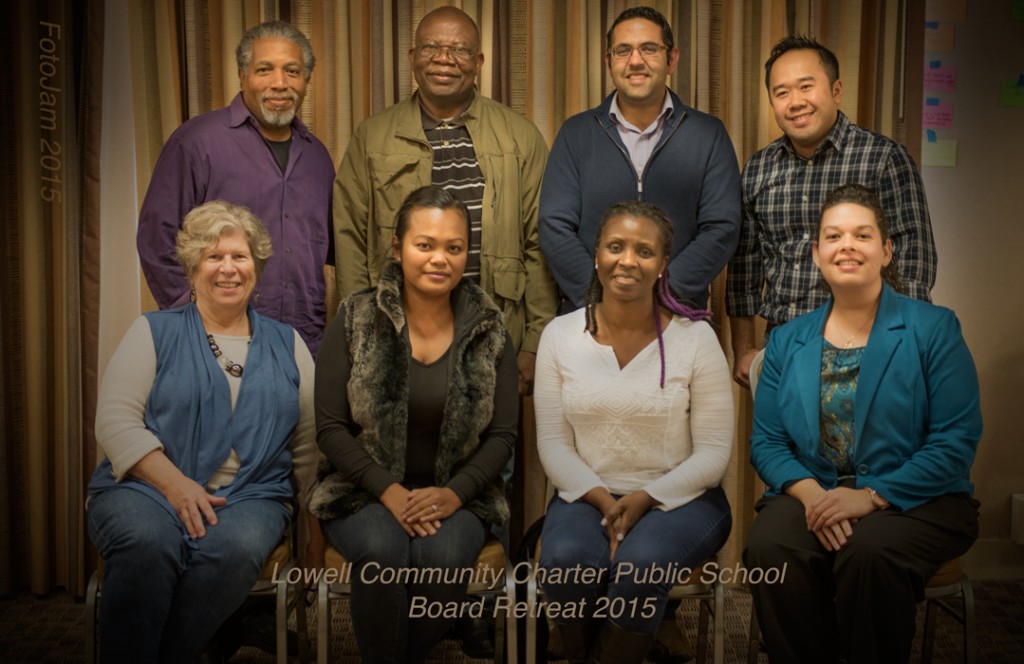(This is a long blog post. You can read it or scan the graphs or play the videos or click the links. It is one story of the successful turnaround of a failing charter school in Massachusetts)
There have been reports and research studies that clearly show that many public school systems are failing children, especially those in high poverty regions of the country. The achievement gap for lower income Black and Latino students is well documented and researched. One answer to this crisis of educational confidence has been the growth of charter schools. These schools are public schools that are run by small teams that are given autonomy from traditional school district and union control but remain accountable for the same student performance results as traditional public schools.
The Charter Movement – Innovation in Education Reform?
The “Charter Movement,” as it is called, has its controversies, critics and vocal supporters. There have been several studies that show that some charters have been able to succeed with students that public schools traditionally fail. One of the foundations of the charter movement is the fact that these schools are held to the same academic standards as any other public school in the state. But unlike traditional public schools, if a charter does not succeed in educating its students (measured by the state’s accountability tests) it faces closure or takeover. The review cycle for a charter school is generally 5 years.
One source of controversy related to the growth of charter schools is the shift in funding from traditional public schools to charters. Each student that enrolls in a charter school reduces the budget of the “sending” school district – generally shifting the state fee paid per student. If 100 students leave the district to go to a charter school the district loses the “revenue” for those students and the charter gets it. That can amount to millions of dollars when a new charter school forms.
Charter schools are managed by a Board of Trustees, who are generally citizen volunteers selected from the community. These Trustees hire the administrators and oversee the school’s program and are accountable to the State for results. The effectiveness of the Board of Trustees to hire the appropriate leadership, provide needed oversight and ensure accountability can make or break a school. When Boards fail to manage, or lack the experience and knowledge to provide oversight or are too aggressive in their control, a school’s leadership has less accountability for results. A successful Board recognizes the needs of its students, hires the leadership needed to create a culture of achievement and monitors the ongoing progress of the program to ensure the school is meeting its student performance targets.
Turnaround – A Real World Perspective
Not every charter school succeeds. Those that are not doing well are forced to change or close. A charter school transformation or turnaround is complex and can take years to accomplish. Living through a real world charter school turnaround provides a perspective of what can be accomplished when a school takes on the challenge of the transformation of culture, curriculum and systems. But for a charter school transformation to be effective, the Board of Trustees and school leadership must have sufficient data and information to be able to diagnose the needs of students, the capacity of faculty for change and the readiness of the current school infrastructure.
As a Board member and Chair of the Academic Achievement Committee of the Board for the Lowell Community Charter Public School (LCCPS), the change process was not without controversy, challenges and head to head confrontations. Removing staff en masse, transforming failing processes and redefining a culture from one of excuses to one of no excuses takes time, effort and patience. The Board created a future vision, found its voice, understood its role and insisted on results that were aggressively monitored over time.
Charter Boards that serve low performing schools do not have the same luxury as those Boards in well established, high functioning schools. Board members need to understand that the radical transformation needed in failing schools, does not happen in one year and is not going to be without complaint and objection. But Boards need to step up and understand their role and focus the school on real and lasting change that creates a culture of achievement supported by the school’s systems and a curriculum aligned to the state’s accountability standards.
Using external talent to leapfrog forward may be very helpful in bringing in “new think” and innovation. Welcoming perspectives outside of the school that may be better able to see the opportunities for rapid change and the obstacles that need to be overcome, can also accelerate growth.
Finding the right balance between Board oversight and leadership’s role to bring about the day-to-day transformation is not easy. Board members without an understanding of the challenges of a school building may be more impatient expecting results in too short a time. School leaders without a clear vision of where they want to go may also struggle with short term fixes that do not address the culture change needed to bring about sustainable and lasting transformation and turnaround.
The Lowell Community Charter Public School – An Inclusive Community
In Lowell Massachusetts one charter school, The Lowell Community Charter Public School (LCCPS) was founded as a K-8 school in 1999 by a group of Lowell parents who were concerned about the escalating violence in the city. Lowell is the 4th largest city in Massachusetts with a population of just over 100,000. It is a city that has attracted very large ethnic communities (47% in 2010). Lowell has the largest population of Cambodians in the US.; a growing population of Africans and stable population of Latinos.
The growth of the multi ethnic city of Lowell was not always peaceful and when violence increased in the late 90s parents came together to create a safe place for students of different nationalities to learn side by side. The origins of Lowell Community Charter Public School are rooted in the desire of multi-ethnic immigrant communities to find a peaceful and safe location for their children to get the necessary education to be successful in America. While those visionary parents were committed to unity, the curriculum of a school serving so many nationalities was harder to establish than expected.
LCCPS started in 2000. In 2010 – ten years later, the Massachusetts Commissioner of Education recommended that LCCPS be closed due to consistent low test scores and ongoing issues with Board mismanagement and failing school leadership. Now, in 2015 LCCPS is a model turnaround charter school that has been studied for its work with ELL students and lauded for its multicultural achievement culture. What follows is one story of LCCPS’ transformation and successful turnaround from the perspective of a Charter Board member.
The LCCPS turnaround results – Video Summary:
By 2013, 3 years into the turnaround of LCCPS students had nearly surpassed the Massachusetts state average for aggregate math performance. In a meeting of the Board of Education in February 2013, the Commissioner of Education recommended that the probationary conditions be removed based on progress and the school was labeled a “profound turnaround.” However, even with this obvious growth, the 7th and 8th grades, eliminated at the time of probation, were not restored.
Based on the continued positive results of the leadership’s academic plan, The Board filed another request for the restoration of grade 7 and 8 later that year. By this time the work of the Board, the leadership and the academic program were well focused and demonstrating sustained growth. The Commissioner of Education recommended the restoration of grades and lauded the school as a model of turnaround for the state. (See video below).
LCCPS’ success is rooted in a fundamental belief of inclusion for all in a community of diverse learners, leaders and teachers. The community is united in the beliefs that every student can learn; high expectations deliver great results; adults are accountable for the future of ALL children in the school community. In 2015 after a successful turnaround, LCCPS expanded enrollment and purchased its facilities in the Appleton Mill Buildings in Lowell accommodating its 7th and the first 8th Grade to graduate since probation in 2010.
One chronological story of turnaround as seen from the eyes of one Board member is detailed below.
2010 A School Community In Crisis
In 2010, knowing that closure was imminent, the leadership of LCCPS rallied the parents and students and launched a “campaign” to forestall a closure. The school community, serving more than 900 students, did not want a forced closure, disruption to students or a forced return to the local district schools.
The school community’s voice along with the fact that it was nearly impossible to place 900 students into a struggling Lowell school district without significant planning, were a few of the reasons for the Commissioner’s to consider giving the school a reprieve.
Instead of closure, the Commissioner and the Board of Education renewed the school’s charter with probationary conditions and stringent requirements for immediate change, including reducing enrollment by nearly 200 students, eliminating, 7th and 8th grades.
In an effort to stabilize the school in 2010 at the time of renewal, it was agreed that the current Board of Trustees would resign en mass over time while new Board members were recruited, resulting in an entirely new Board of Trustees assembled within a span of months. These new Board members were recruited knowing LCCPS was in crisis, facing immanent closure if an aggressive campiagn of change that delivered demonstrable progress was not initiated.
At the time this new Board was assembled, the school’s crisis continued. The strongest members of the leadership team were leaving. The best teachers, in fear of future layoffs, left and found other jobs. Many families returned to the local district schools. During this crisis of confidence the Board had to find new leadership to manage the school, a requirement of its probationary charter renewal.
In 2010 an aggressive turn-around plan was quickly cobbled together and the school community started on the very bumpy road of turn-around. As one of the new Board members recruited to this school in the crisis period of 2010, I have served as Vice Chair, Chair of Governance and as a member of the Strategic Planning and Development Committees. However, my primary focus and role throughout the transformation and turnaround was serving as the Chair of the Academic Achievement Committee of the Board.
The Data Tells One Story of Transformation and Turnaround
The results of the LCCPS transformation are described in the charts and graphs below:
*Scores for 2015 from PARCC results are on a different scale but included for comparison.
LCCPS was far behind the state average in ELA and Math in 2008, prior to when the turnaround effort began. The threat of closure and non-renewal in 2010 sent the school community into a frenzied attempt to strengthen the school and better serve its students. By 2011 when a new Board and leadership team was settling in, the school was on the way to transformation. By 2014 the gap to the state average on the MCAS was closed for math and just within reach for ELA. The graphs below clearly shows the impact of the turnaround on student performance for math and ELA.
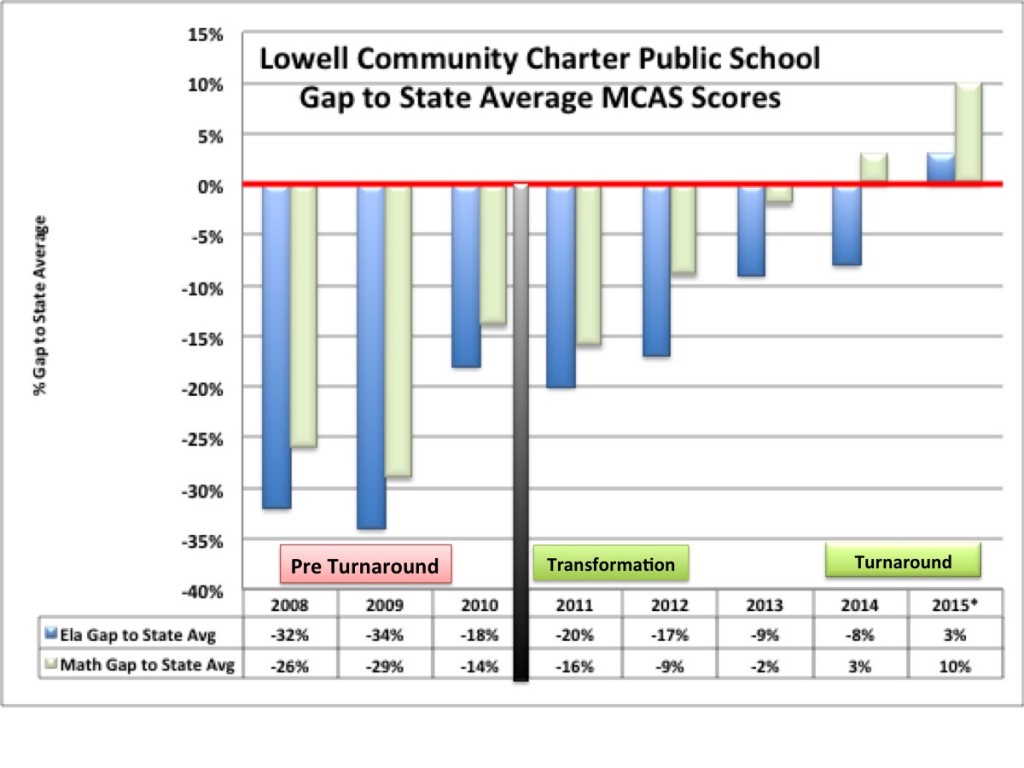 In the years before the Commissioner of Education mandated that LCCPS transform or face closure, student performance results were more than 25% below the state average for ELA and Math. At that time the Board was less focused on academic progress and the school leadership was stating publicly that the school was a safe place for students whose language difficulty and socioeconomic background were holding them back academically. In essence, the results for LCCPS in 2008 and 2009 were claimed to be the result of the difficulties and challenges that the students were facing in their daily lives in lower income neighborhoods and not a result of the teaching within the school building.
In the years before the Commissioner of Education mandated that LCCPS transform or face closure, student performance results were more than 25% below the state average for ELA and Math. At that time the Board was less focused on academic progress and the school leadership was stating publicly that the school was a safe place for students whose language difficulty and socioeconomic background were holding them back academically. In essence, the results for LCCPS in 2008 and 2009 were claimed to be the result of the difficulties and challenges that the students were facing in their daily lives in lower income neighborhoods and not a result of the teaching within the school building.
As can be seen from the chart above, in the early years (2008 – 2009) LCCPS was diverse with 41% Hispanic, 30% Asian (mostly South East Asian), and a smaller segment of White (14%) and Black (10%) students. During the threat of closure in 2010 and the chaotic transformation of 2011 many families left the school and returned to the Lowell district. This was especially true for White families. The fact that the 7th and 8th grades were eliminated as part of the probationary conditions made it difficult for many families with older children that had to attend multiple schools because of the unusual grade configuration of LCCPS (as compared to the Lowell District).
The LCCPS Community Expands
African/African American families in Lowell looking for an alternative to the district schools were aggressively recruited during this period to fill the enrollment gaps left by departing families. As the transformation took hold, the recruitment efforts in the respective ethnic populations of Lowell became easier and the attrition rate for current students began to decline precipitously. By 2014, when it was clear that the transformation had been accomplished, the ethnic populations within the school were well established and the diverse groups were working in harmony to enhance the educational outcomes of the students.
The rationale often used by school leaders for failing student academic results focus on the challenges faced by the students. It is well known that poverty has been highly correlated to student outcomes. It is also well documented that English language learners are known to struggle academically as they try to master subject matter necessary for state accountability tests. The LCCPS student population faced these same challenges.
Many students in LCCPS were new immigrants or first generation born in the US. For many students, English was their second or third language. As the chaos of transformation was occurring in 2011 and students were leaving the school to return to the district, the families most in need were often the ones that remained in the school. English language learners increased during the transition and the number of children from low income families increased. Recruitment efforts to bring in new students during this crisis were difficult as the school’s probation and possible closure were widely covered in the local newspapers.
Student Results
In the following graphs we explore the transformation and turnaround of LCCPS using results from the state’s annual assessment for Math called the MCAS (Massachusetts Comprehensive Assessment System). We primarily focus on math given the variation in language ability of the students within the LCCPS. MCAS scores are categorized, like many states, into ranges of performance based on results. For our analysis we look at those students that were rated as “proficient or above.” It should also be noted that Massachusetts math standards are considered to be among the most rigorous in the country.
Transformation and Cohort Analysis
The impact of transformation on student results can also be explored by the progress made by specific cohorts of students. We trace the results of specific 3rd grade cohorts and follow their math MCAS results through to their 6th grade year.
In the following graphs, the first column represents the 3rd grade for a given year. The second column plots the results from that same group of students for their 4th grade year. The third column plots the results from that same group for their 5th grade year. And the fourth column plots the results from that same group for their 6th grade year. These grade 3 through 6 “cohorts” allow us to see the progress of a group of students over several years and several grades.
2008 3rd Grade Cohort
Before transformation began the MCAS math results of those students in 3rd grade in 2008 were 34% proficient or advanced, well below the state average of 61% proficient and above. This same cohort of students had results that declined during their 4th grade year and during the crisis year of 2010 while in the 5th grade this cohort remained well below the state average.
This cohort of students was exposed to the culture of the failing school and also experienced the crisis of closure and the transition. During a threatened closure, the leadership of a charter often rallies the parents, students and community to “fight” to keep the school open. Closing a school is a traumatic event (as can be seen in this video of one school closed in Worcester MA). The disruption in the lives of the school community is significant, especially for students, many of whom are facing daily challenges of poverty, homelessness and domestic instability. Parents, many from lower income communities, do not understand the reasons that charter schools should be closed. For them it is one more de-stabilizing event in lives that are often filled with uncertainty. The 2008 3rd graders at LCCPS were in for the rough ride of charter renewal, threat of closure and probation.
2009 3rd Grade Cohort
The next year the 3rd grade cohort for 2009 did not do much better. The math results of 31% proficient or advanced declined in 4th grade the year of the crisis. By 6th grade and 2 years into the transformation this cohort climbed to 51% proficient or advanced. This cohort lived through the crisis and culture change of the transition to transformation.
2010 3rd Grade Cohort
In 2010 the 3rd grade and the school community were in the midst of many transitions. The school community was in constant crisis launching its campaign to forestall the closure and to find new leadership and board members. The school was facing uncertainty and families that had the means and understanding of the magnitude of crisis were leaving the school to return to the district schools.
2011 3rd Grade Cohort
By 2011 the transformation was well underway but the ability to attract and retain teachers for a failing school was difficult resulting in teacher turnover rates well above 20%. The changes in leadership structure and governance were making a difference. The management company hired by the Board in 2010 completed a school wide teacher evaluation resulting in lay offs of nearly 50% of teaching staff. Additionally the management company invested in professional development to instill a culture of achievement and consistent classroom management within a faculty with very low morale. A key staffing change was also made, creating a position of “achievement specialist” staffed by a highly qualified educator that was both familiar with and advocating for a more data driven approach to instructional leadership. This role was key to the results the school achieved throughout.
The achievement specialist was given the responsibility to bring about a greater level of standardization to the curriculum while focusing on alignment with the state standards. New digital tools were adopted to create a unified curriculum where data could be used to better inform teachers, helping them to differentiate and group students based on individual need and skills gaps. A multi-year culture change began that was data driven, focused on understanding the needs of each individual child while using technology tools to align the curriculum vertically and horizontally to the rigorous Massachusetts standards.
The 2011 3rd grade cohort showed that the stabilization plan was working and the results over time showed the impact of greater cohesiveness in the teaching staff, the focus of the Board on demonstrable academic results, raised expectation for outcomes from faculty and the leadership’s success in lowering attrition rates of student and faculty.
The Board Takes Greater Control
In 2012 the Board ended its relationship with the management company. The Board empowered the Head of School to take on the day-to-day management of the school and adopted a strategy of working with key external partners as consultants and advisers. The Board had members that were themselves consultants in education and business with careers in project management, finance and organizational turnaround. The Board, adopted a plan to find external expertise and advisers needed for specific identified challenges (outsourcing to leapfrog forward) while at the same time building a focused and cohesive governance and leadership team. The Board also launched a school-wide Strategic Planning Initiative that focused the community on specific long term objectives and goals. That plan embodied the desires of the community and articulated the specific actions needed by the leadership team to achieve stability and growth.
2013 3rd Grade Cohort
By 2013 the 3rd grade cohort’s MCAS math results (74% proficient or advanced) were surpassing the state average (61%). The focus on early literacy and math skills preparation in the lower grades was making a difference in outcomes. The 2013 cohort clearly demonstrated that a turn around had been achieved. By this time the newly appointed Board from 2010 had evolved, grown in its understanding of charter education and board roles establishing well functioning committees and establishing operating procedures and norms. Expectations across the school had been raised, attrition rates started to fall (student and faculty) and a sense of accomplishment began to permeate the school from teachers to students to parents.
2014 3rd Grade Cohort
The turnaround proved to be sustainable. In 2014, the 3rd grade cohort once again surpassed the math results of the sate by 10% with LCCPS 3rd grade results of 78% proficient or advanced compared to the state average of 68%. By this time the work of the Achievement Specialist was well entrenched in the culture of the school. The data focus was shared with many other schools that were studying the LCCPS turnaround. The Head of School recognizing that the return of 7th and 8th grade would require more space embarked on the purchase of a larger portion of the Appleton Mill buildings in Lowell increasing it physical footprint and making the school a true Lowell cultural icon. By 2014, the academic program was working well, the turnaround complete and the school was facing its next 5 year charter renewal.
The Board’s Ongoing Focus on 3rd Grade
The Board’s Academic Achievement Committee, throughout the transformation and turnaround, focused much attention on 3rd grade results as one key measure of the success of the turnaround program. The leadership of the school, aligned with a focus on 3rd grade, ensured that the school enhance its early literacy and math education. 3rd graders were well prepared PRIOR to their first MCAS test.
The graph below shows the MCAS math results of 3rd grade for the years 2008 – 2014 with comparison to the math state average. In the pre-turnaround stage the gap between LCCPS and the state average results is clear. The gap started to close as the transformation launched and within 3 years the scores for LCCPS 3rd grade students surpassed the state average demonstrating both a turnaround and the impact of a focused plan to educate the ethnic and multi-lingual students in Lowell. The turnaround was clearly demonstrated and sustained by 2014.
The turnaround was also confirmed by looking at the same type of graph for math for the 6th grade throughout the years 2008 – 2014. As can be seen from the graph below the gap in math results between LCCPS and the state average for the 6th grade in the pre-turnaround period was significant. As the transformation began in 2010 and 2011 the gap started to close. By 2013 and 2014 the MCAS math scores surpassed the state averages, again confirming the sustainability of the transformation.
It’s Tough, But the Outcome is Rewarding – Working Through a School Turnaround
My 6 years of volunteer service on the Board of LCCPS, in many roles, has been most rewarding and fulfilling. The responsibility has caused a few sleepless nights, especially when having to consider the real world issues of more than 800 families and 150 staff. But the most rewarding of any of my positions on the Board of Trustees has been in my role as Chair of the Academic Achievement Committee where I was able to collaborate with dedicated educators that brought about what most outsiders will clearly see is a sustainable transformation of a failing school into a successful school community. I believe that LCCPS will serve the students of Lowell for decades to come and hopefully serve as a model of turnaround for many schools across the country.
LCCPS is an inclusive school community serving students from many backgrounds. The Board strives to reflect the community and maybe one of the most diverse charter school boards in Massachusetts. My 6 year term ends in June 2016.
The 2015-2016 Board of Trustees, Lowell Community Charter Public School
Standing: Tyrone Mowatt, Fru Nkimbeng, Imran Oomer, Hung Mai
Sitting: Kathy Egmont (Head of School), Doeun Kol (Chair), Esther Nganga, Cristina Freitas

